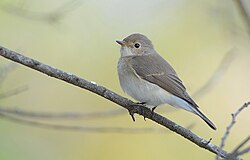| Image | Common name | Scientific name | Distribution |
|---|
 | Yellow-rumped flycatcher | Ficedula zanthopygia | Manchuria, China and Korea; winters to Malay Peninsula and Sumatra |
| - | Green-backed flycatcher | Ficedula elisae | northeastern China; winters to Malay Peninsula |
 | Narcissus flycatcher | Ficedula narcissina | Kuril Islands, Manchuria and Japan; winters to Hainan, northeastern Borneo and Philippines |
 | Ryukyu flycatcher | Ficedula owstoni | Ryukyu Islands |
 | Slaty-blue flycatcher | Ficedula tricolor | Himalayas, central China, Yunnan and northern Indochina |
 | Snowy-browed flycatcher | Ficedula hyperythra | Himalayas, southern China, Taiwan and Southeast Asia |
 | Mugimaki flycatcher | Ficedula mugimaki | Mongolia, Korea, southern Siberia and northeastern China; winters to Southeast Asia |
 | Slaty-backed flycatcher | Ficedula erithacus | eastern Himalayas, central/southern China; winters to northern Indochina |
 | Pygmy flycatcher | Ficedula hodgsoni | eastern Himalayas and Southeast Asia |
 | Rufous-gorgeted flycatcher | Ficedula strophiata | Himalayas, Patkai, central/southern China, northern Indochina and eastern Vietnam |
 | Sapphire flycatcher | Ficedula sapphira | Eastern Himalaya, central/southern China and northern Indochina |
 | Ultramarine flycatcher | Ficedula superciliaris | eastern Afghanistan to Hengduan Mountains; winters in India and northwestern Indochina |
 | Little pied flycatcher | Ficedula westermanni | Himalayas and Southeast Asia |
 | Rusty-tailed flycatcher | Ficedula ruficauda | Tian Shan and Himalayas; winters to Western Ghats |
 | Kashmir flycatcher | Ficedula subrubra | Nilgiri Mountains and Sri Lanka |
 | Red-breasted flycatcher | Ficedula parva | Europe and Caucasus ; winters to South Asia |
 | Taiga flycatcher | Ficedula albicilla | Siberia; winters to Indomalaya |
 | Semicollared flycatcher | Ficedula semitorquata | eastern Mediterranean; winters to East Africa |
 | Atlas pied flycatcher | Ficedula speculigera | north-west Africa |
 | European pied flycatcher | Ficedula hypoleuca | Europe; winters to equatorial Africa |
 | Collared flycatcher | Ficedula albicollis | Europe; winters to southeastern Africa |
 | Black-and-orange flycatcher | Ficedula nigrorufa | southern Western Ghats |
 | Tanimbar flycatcher | Ficedula riedeli | Tanimbar Islands (Larat and Yamdena) |
 | Rufous-chested flycatcher | Ficedula dumetoria | Malesia |
| - | Furtive flycatcher | Ficedula disposita | Luzon |
 | Palawan flycatcher | Ficedula platenae | Palawan |
 | Rufous-throated flycatcher | Ficedula rufigula | Sulawesi |
| - | Cinnamon-chested flycatcher | Ficedula buruensis | Maluku Islands (Buru, Seram and Kai Besar) |
| - | Sumba flycatcher | Ficedula harterti | Sumba |
 | Black-banded flycatcher | Ficedula timorensis | Timor |
 | Little slaty flycatcher | Ficedula basilanica | Philippines Mindanao, Leyte and Samar |
 | Bundok flycatcher | Ficedula luzoniensis | montane Philippines |
 | Cryptic flycatcher | Ficedula crypta | Mindanao |
| - | Lompobattang flycatcher | Ficedula bonthaina | Lompobattang Massif, Sulawesi |
 | Damar flycatcher | Ficedula henrici | Damar Island |
|































